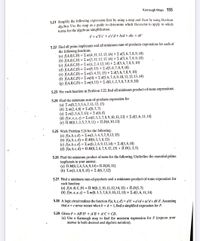
Introductory Circuit Analysis (13th Edition)
13th Edition
ISBN: 9780133923605
Author: Robert L. Boylestad
Publisher: PEARSON
expand_more
expand_more
format_list_bulleted
Question

Transcribed Image Text:Karnaugh Maps 155
5.21 Simplify the following expression first by using a niap and then by using Boolean
alecbra. Use the nap as a guide to determine which theorenis to apply to which
terms for the algebraic simplification.
F = a'b'c' + a'c'd + bcd + abc + ab'
5.22 Find all prime implicants and all mininum sum-of-products expressions for each of
the following functions.
(a) (A,B.C.D) = E m(4, 11, 12, 13, 14) + E d(5,6,7,8,9, 10)
(b) f(A,B,C,D) = L m(3, 11, 12, 13, 14) + E d(5,6,7,8,9. 10)
(c) f(A,B.C,D) = £ m(1, 2, 4, 13, 14) + £ d(5, 6, 7,8,9, 10)
(d) (A,B,C.D) = £ m(4, 15) + d(5,6, 7, 8,9, 10)
(e) f(A,B,C,D) = L m(3,4, 11, 15) + £ d(5,6,7,8,9, 10)
() f(A,B,C,D) = I m(4) +E d(5,6,7,8, 9, 10, 11, 12, 13, 14)
(g) fA,B,CD) = £ m(4, 15) + £ d(0, 1, 2,5, 6, 7, 8,9, 10)
5.23 For each function in Problem 5.22, find all minimum product-of-sums expressions.
5.24 Find the minimum sum-of-products expression for
(a) E m(0,2, 3,5,6, 7, 11, 12, 13)
( 6) Σm(2,4,8) +Σ d(0,3, 7)
( c ) Σm(1,5, 6,7, 13 ) + Σ d44,8
(d) f(w, x, y, z) = £ m(0, 3,5, 7, 8,9, 10, 12, 13) + E d(1,6, 11, 14).
(е) П М(0, 1,2,5, 7,9, 11) - П D(4,10, 13)
5.25 Work Problem 5.24 for the following:
(a) f(a, b, c, d) = E m(1,3,4,5,7,9,13, 15)
(b) f(a, b, c, d) = II M(0,3,5, 8, 11)
(c) f(a, b, c, d) = 2 m(0,2, 6, 9, 13, 14) + E d(3,8, 10)
(d) f(a, b, c, d) = II M(0,2,6, 7,9, 12, 13) • II D(1,3,5)
5.26 Find the minimum product of sums for the following. Underline the essential prime
implicants in your answer.
(a) II M(0,2, 4,5, 6, 9,14) • II D(10, 11)
( b) Σm(1 ,3 , 8,9, 15)+ Σd(6,7, 12 )
5.27 Find a minimum sum-of-products and a minimum product-of-sums expression for
each function:
(a) f(A, B, C, D) = II M(0,2, 10, 11, 12, 14, 15) • II D(5,7)
(b) f(w, x, y. z) = E m(0,3, 5,7,8, 9, 10, 12, 13) + 2 d(1,6, 11, 14)
5.28 A logic circuit realizes the function F(a, b, c, d) = a'b' + a'cd + ac'd + ab'd'. Assuming
that a = c never occurs when b = d = 1, find a simplified expression for F.
5.29 Given F= AB'D' + A'B + A'C + CD.
(a) Use a Karnaugh map to find the maxterm expression for F (express your
answer in both decimal and algebric notation).
Expert Solution
This question has been solved!
Explore an expertly crafted, step-by-step solution for a thorough understanding of key concepts.
This is a popular solution
Trending nowThis is a popular solution!
Step by stepSolved in 5 steps

Knowledge Booster
Learn more about
Need a deep-dive on the concept behind this application? Look no further. Learn more about this topic, electrical-engineering and related others by exploring similar questions and additional content below.Similar questions
- 36. Convert the Boolean expression A(BC+ DE) to SOP form. a. ABC + ADE b. ABCDE c. A + BCDE d. ABC + DEarrow_forwardBy algebraic manipulation, reduce the given Boolean expression to its simplest form and express your answer in SOP form: (A' + C) (A' + C') (A + B + C'D)arrow_forwardCan you reduce this boolean equation down to 3 IC's?arrow_forward
- Please solve and show all work for the following Discrete Math problem. Thank you so much. Have a great day!arrow_forwardplease solve utilizing boolean algebra.arrow_forward4. Simplify the expression for F into sum of products form (((ab) + c) + d) F = Note: A product term consists of the AND of one or more Boolean variables either in complemented or uncomplemented form. Sum of products is the OR of one or more of such product terms.arrow_forward
arrow_back_ios
arrow_forward_ios
Recommended textbooks for you
 Introductory Circuit Analysis (13th Edition)Electrical EngineeringISBN:9780133923605Author:Robert L. BoylestadPublisher:PEARSON
Introductory Circuit Analysis (13th Edition)Electrical EngineeringISBN:9780133923605Author:Robert L. BoylestadPublisher:PEARSON Delmar's Standard Textbook Of ElectricityElectrical EngineeringISBN:9781337900348Author:Stephen L. HermanPublisher:Cengage Learning
Delmar's Standard Textbook Of ElectricityElectrical EngineeringISBN:9781337900348Author:Stephen L. HermanPublisher:Cengage Learning Programmable Logic ControllersElectrical EngineeringISBN:9780073373843Author:Frank D. PetruzellaPublisher:McGraw-Hill Education
Programmable Logic ControllersElectrical EngineeringISBN:9780073373843Author:Frank D. PetruzellaPublisher:McGraw-Hill Education Fundamentals of Electric CircuitsElectrical EngineeringISBN:9780078028229Author:Charles K Alexander, Matthew SadikuPublisher:McGraw-Hill Education
Fundamentals of Electric CircuitsElectrical EngineeringISBN:9780078028229Author:Charles K Alexander, Matthew SadikuPublisher:McGraw-Hill Education Electric Circuits. (11th Edition)Electrical EngineeringISBN:9780134746968Author:James W. Nilsson, Susan RiedelPublisher:PEARSON
Electric Circuits. (11th Edition)Electrical EngineeringISBN:9780134746968Author:James W. Nilsson, Susan RiedelPublisher:PEARSON Engineering ElectromagneticsElectrical EngineeringISBN:9780078028151Author:Hayt, William H. (william Hart), Jr, BUCK, John A.Publisher:Mcgraw-hill Education,
Engineering ElectromagneticsElectrical EngineeringISBN:9780078028151Author:Hayt, William H. (william Hart), Jr, BUCK, John A.Publisher:Mcgraw-hill Education,

Introductory Circuit Analysis (13th Edition)
Electrical Engineering
ISBN:9780133923605
Author:Robert L. Boylestad
Publisher:PEARSON

Delmar's Standard Textbook Of Electricity
Electrical Engineering
ISBN:9781337900348
Author:Stephen L. Herman
Publisher:Cengage Learning

Programmable Logic Controllers
Electrical Engineering
ISBN:9780073373843
Author:Frank D. Petruzella
Publisher:McGraw-Hill Education

Fundamentals of Electric Circuits
Electrical Engineering
ISBN:9780078028229
Author:Charles K Alexander, Matthew Sadiku
Publisher:McGraw-Hill Education

Electric Circuits. (11th Edition)
Electrical Engineering
ISBN:9780134746968
Author:James W. Nilsson, Susan Riedel
Publisher:PEARSON

Engineering Electromagnetics
Electrical Engineering
ISBN:9780078028151
Author:Hayt, William H. (william Hart), Jr, BUCK, John A.
Publisher:Mcgraw-hill Education,